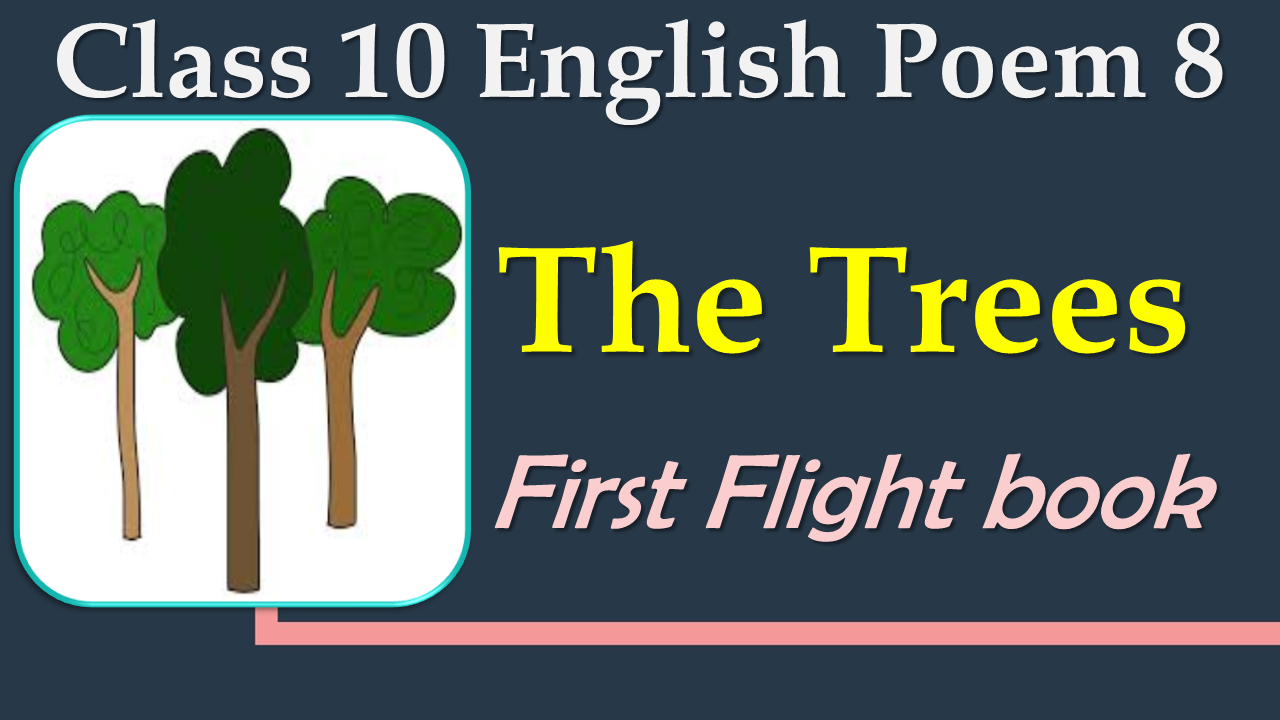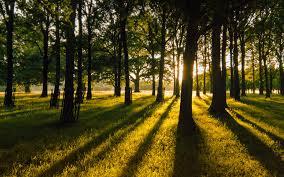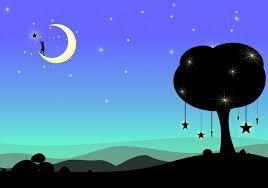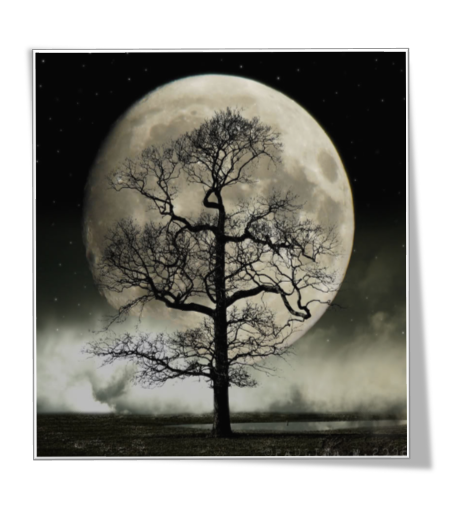Class X- Poem - 8 (First Flight)-"The Trees"by Adrienne Rich


About the Poet
Adrienne Rich (1929-2012) was born in Baltimore, Maryland, USA. She was a famous poet, essayist and feminist. She has published nineteen volumes of poetry, three collections of essays and other writings.
Central Idea of he Poem
The poem The Trees’ by Adrienne Rich shows the conflict between man and nature.
With the growth and development of society, human beings have used nature for
their own benefit and caused a lot of harm to it. In order to use natural
resources like forests, minerals etc. men have forgotten the importance of
nature. The poet wants to give the message that the presence of a few trees
inside our homes does not become equal to nature, it is a very false idea of
nature. Real nature is outside, in the forests that we have destroyed.
The trees in the speaker’s house want to break the walls of the house and move
to the forest which has become empty. The birds can sit again on their
branches, the insects can hide there and the sun rays can disappear under the
shadow of the trees. The poem tells us how the trees want to break free from
the walls that humans have put around them, and go out in the forest.
The Trees Summary
The poet talks about trees symbolically. They refer to women who have been healed and are ready to move out of their houses to fulfil their primary purpose - to renew the forest of mankind. As women have remained indoors, the forest has become empty, the birds and insects rendered shelterless. The Sun’s rays do not have the tree trucks and leaves to fall upon and thus, reach the earth. She says that the forest will be full of trees the next morning. The roots of the trees are working hard to separate from the floor of the veranda where they have remained fixed. The leaves and branches are moving towards the glass windows. They are desperate to move out just like a newly discharged patient who has not recovered completely, moves to the exit door of the hospital in a hurry. The poet is sitting in her house with the doors of the veranda open. She is writing letters but does not mention this movement of the trees. It is night time, the sky is clear and a bright moon is visible. She can smell the leaves and lichen which seem to be calling out desperately. She hears the glass of the window pane breaking. The trees are moving out and the fast blowing wind embraces them. As the trees have reached the forest, the tall and strong oak tree overshadows the moon and it seems that the moon has been broken into several pieces.STANZA-WISE EXPLANATION
Stanza 1

The trees inside are moving out into the forest,
the forest that was empty all these days
where no bird could sit
no insect hide
no sun bury its feet in shadow
the forest that was empty all these nights
will be full of trees by morning.
WORD MEANINGS
Empty – vacant, hollow, missing
Bury – cover something so that it is not visible
EXP-The poet says that the trees are moving out of the confines of the houses, into the open forest. This is unreallistic as trees are immoveable and hence, we realize that the poem has a symbolic meaning. We interpret that trees refer to females who have healed themselves and are ready to move out of their homes, into the forests to fulfil their primary purpose of filling the world with mankind. Further she adds that the forest has been empty for the past many days and so, no birds can be seen as they do not have any trees to sit on, on insects can be seen as they do not have any shelter and the Sunlight cannot form any shadows. The forest of humanity has remained empty for many days but will soon be full and bright.
Literary Devices:
Personification: Sun bury it’s feet. Sun has been personified.
Anaphora: 2 lines begin with ‘no’
imagery: “The trees inside are moving out into the forest” - shows kinestatic imagery
Enjambment: Continuation of a sentence to the next line (the forest that was…… trees by morning).
Stanza 2
All night the roots work
to disengage themselves from the cracks
in the veranda floor.
The leaves strain toward the glass
small twigs stiff with exertion
long-cramped boughs shuffling under the roof
like newly discharged patients
half-dazed, moving
to the clinic doors.
WORD MEANINGS
Disengage: remove
Strain: pressure
Twigs: small stem
Exertion: effort
Cramped: restricted
Boughs: branch
Shuffling: mixing
Discharged: send out
Dazed: stun
EXP- The poet explains the struggle done by the plants to reach the forest. She says that the roots worked for the whole night to separate themselves from the veranda floor. The leaves tried hard to reach the window of glass so that they could go outside. Even the small stems of the trees put much of their effort in order to set themselves free. The big branches were also trying a lot to go out from the roof of the room. We can say that women are desperate for a change and their effort is compared to that made by a patient who has been released from the hospital and he tries to move out in a hurry although he is confused. Maybe because they are half conscious and are under the influence of some medication, they are unsteady but in a hurry to leave the clinic.
Literary Devices:
Enjambment: continuation of sentence to the next line (the leaves strain……. Half dazed)
Simile: trees compared to patients (like newly discharged patients)
personification: twigs and boughs have been personified.

Stanza 3
I sit inside, doors open to the veranda
writing long letters
in which I scarcely mention the departure
of the forest from the house.
The night is fresh, the whole moon shines
in a sky still open
the smell of leaves and lichen
still reaches like a voice into the rooms
WORD MEANINGS
Scarcely: barely
Departure: leaving
Lichen: crusty patches of bushes of fungus and algae on tree trunks, having a distict smell
EXP- The poet says that she is sitting in her veranda, writing long letters. She does not mention about the trees leaving her house in her letters. She says that the night is very clear. She can see the complete moon which is shining. The smell of leaves and lichens is like a voice which is yelling and expressing a desire for freedom from the confines of the house.
Literary Devices:
Alliteration: ‘long letters’ forest from’ ‘sky still’ ‘leaves and lichen’
Enjambment: continuation of sentence to the next line (doors open….the house)
Imagery: the poet has tried to create a scene in which she is observing all the things happening (the night is fresh……into the rooms)

Stanza 4
My head is full of whispers
which tomorrow will be silent
Listen. The glass is breaking.
The trees are stumbling forward
into the night. Winds rush to meet them.
The moon is broken like a mirror,
its pieces flash now in the crown
of the tallest oak.
WORD MEANINGS
Whispers: murmur
Stumbling: trip over
Flash: glare, shine
Oak: A large, strong tree generally used for making furniture
EXP- Her head is full of the slow sounds made by the trees which are desperate to move out. These sounds will not be heard the next day. The poet asks the reader to listen carefully as a change is about to take place. She hears the glass window breaking and the trees stumble out into the night. The wind is blowing outside. It meets the trees. The moon is like a mirror and it appears to have been broken into pieces as the shadow of the oak tree divides the moon into many fragments.
Literary devices:
Simile: The moon is compared to a mirror (Moon is broken like a mirror)Rhyme scheme
There is no rhyme. The Poem is in free verse.
TEXT BOOK - Question and Answers
Q1-(i) Find, in the first stanza, three things that cannot happen in a treeless forest?
Ans: The three things mentioned in the first stanza that cannot happen in a treeless forest are:
- Birds sitting on the tree branches.
- The hiding of insects in the branches of trees
- The sun burying its feet in the shadow of the trees in the forest.
(ii) What picture do these words create in your mind: “… sun bury its feet in shadow…”? What could the poet mean by the sun’s ‘feet?’
Ans: The sun’s feet are the rays of sun that reach the earth after falling on the leaves of the trees and finally, reach the earth’s surface.
Q2- (i) Where are the trees in the poem? What do their roots, their leaves, and their twigs do?
Ans: The trees are in the poet’s house. The roots are working hard to remove themselves from the cracks of veranda. The leaves are making an effort to reach towards the glass in order to come out and the twigs are making attempts to set themselves free and reach the forest.
(II) What does the poet compare their branches to?
Ans: The poet uses the word long cramped for the branches. She says that the branches are trying hard to come out of the roof. She then compares them with newly discharged patients who are trying to move out in their half consciousness.
Q3- (I) How does the poet describe the moon: (a) at the beginning of the third stanza, and (b) at its end? What causes this change?
Ans: The poet describes the moon as a full moon in the beginning of the third stanza but at the end of the stanza, she describes it to be broken into pieces. The change in the moon is because of the trees. The trees that earlier were in the poet’s house have now reached the forest. Their long branches have cast a shadow on the full moon and now it appears to be broken into pieces like a mirror.
(II) What happens to the house when the trees move out of it?
Ans: The house becomes silent as the fragrance of the leaves and lichens which was like a voice urging for a change can no longer be smelt.
(III) Why do you think the poet does not mention “the departure of the forest from the house” in her letters? (Could it be that we are often silent about important happenings that are so unexpected that they embarrass us? Think about this again when you answer the next set of questions.) ?
Ans: The poet did not mention the departure of the forest from her house because it is a part of human nature to ignore the important matters of their life. We all know that trees are so important for our survival on earth. But still human beings are cutting them for making profits without even thinking of the aftermath.
Q4- Now that you have read the poem in detail, we can begin to ask what the poem might mean. Here are two suggestions. Can you think of others?
- Does the poem present a conflict between man and nature? Compare it with A Tiger in the zoo. Is the poet suggesting that plants and trees, used for ‘interior decoration’ in cities while forests are cut down, are ’imprisoned’ and need to ‘break out’?
Ans: Yes, the poem presents a conflict between man and nature. Man is causing deforestation by cutting down the trees for his own use. On the other hand, he decorates his house with the trees. We are damaging our environment without even thinking about the end results. By clearing up the forests, we are endangering ourselves. So is with the animals too. We are ruining their natural habitat and killing them for our fun or food but on the other hand, we are keeping them in the cages on the pretext of safeguarding them by making sanctuaries and zoos. So, it is true that we are in a direct conflict with nature and making the other living beings prisoners, be it the trees or animals.
- On the other hand, Adrienne Rich has been known to use trees as a metaphor for human beings; this is a recurrent image in her poetry. What new meanings emerge from the poem if you take its trees to be symbolic of this particular meaning?
Ans: If trees are to be taken as a symbol for human beings, then the poem will define the efforts of humans to free themselves from the clutches of the desire to achieve everything. All the human beings are under a constant pressure of being at the top in every field. Either they are forced by their own desire of doing so or there is a constant peer pressure on them. So, the human beings will set themselves free from this race and try to live a happy and peaceful life.
EXTRA QUESTIONS - ANSWERS
Extract
Based Questions
Read the lines given below and answer
the questions that follow :
Question 1. The trees inside are moving out into the
forest, the forest that was empty all these days Where no bird could sit no
insect hide
no sun bury its feet in shadow.
(a) Which three things cannot happen in a treeless forest ?
(b) Why was the forest empty ?
(c) Which word here means ‘hide from view’ ?
(d) Name the poem and the poet
Answer: A forest is a natural habitat for numerous birds and insects.
When forests are cleared no bird can make its
nest, nor can insects hide in the bark of the trees and there’s nothing to
shade the area from sunlight.
(b) The forests are empty and devoid of trees because they are cut down to
create land for cultivation and expansion of cities.
(c) In the given extract, ‘bury’ means to hide from view.
(d) The poem ‘The Trees’ is written by Adrienne Rich.
Question 2.The trees inside are moving out into the
forest, the forest that was empty all these days where no bird could sit no
insect hide
no sun bury its feet in shadow
the forest that was empty all these nights
will be full of trees by morning
(a) The bird did not sit on trees as ………..
(b) The forest was empty because there were no ………..
(c) Here, ‘The trees are moving’ refers to …………
(d) No insect can hide
Answer: there were no trees.
(b) trees.
(c) g owing out of the glass.
(d) as there are no trees.
Question 3. The leaves strain toward the glass Small twigs stiff with exertion Long cramped boughs shuffling under the roof Like newly discharged patients Half dazed moving To the clinic doors.
(a) Why do the leaves strain towards the glass ?
(b) What are branches compared to ?
(c) What is the figure of speech in Tike newly discharged patients’ ?
(d) Which word means the same as ‘leaves’ ?
Answer: (a) The leaves strain towards the glass to escape their
captivity.
(b) Branches here are compared to patients.
(c) simile.
(d) Twigs.
Question 4. I sit inside, doors open to the verandah
Writing long letters
In which I scarcely mention the departure of the forest from the house.
The night is fresh, the whole moon shines
in a sky still open
the smell of leaves and lichen
still reaches like a voice into the rooms.
(a) The names of the poem and the poet are ……….
(b) The figure of speech used in the last line of the stanza is ………..
(c) The doors are opening in the ………
(d) Which word means the same as ‘fragrance’ ?
Answer: (a) The name of the poem is ‘Trees’ and its poet is Adrienne
Rich.
(b) Simile.
(c) Verandah.
(d) Smell
Question 5. Listen. The glass is breaking.
The trees are stumbling forward into the night. Winds rush to meet them.
The moon is broken like a mirror, its pieces flash now in the crown, of the
tallest oak.
(a) Who is breaking the glass ?
(b) The wind rushes to greet the ……..
(c) The figure of speech used in the line.
The moon is broken like a mirror is …………….
(d) The pieces of the mirror flash …………
Answer: (a) The branches of the tree are
breaking the glass.
(b) trees.
(c) Simile.
(d) in the crown of the tallest oak
Question 6. The moon is broken like a mirror;
Its pieces flash now in the crown Of the tallest oak.
(a) Whom do winds rush to meet ?
(b) How does the moon look ?
(c) Name the poem and the poet ?
(d) Which poetic device is used in the above lines ?
Answer: (a) Winds rush to meet trees.
(b) It looks like a broken mirror.
(c) ‘ Trees’ by Adrienne Rich.
(d) Simile
Short Answer Type Questions
Question 1. Where are the trees in the poem ? What
do their roots, their leaves and twigs do ?
Answer: The poem by Adrienne Rich is referring
to the trees grown indoor for their aesthetic beauty. The poet imagines that
the trees are stiffled in confined places and struggle to move in the open
towards their natural habitat. The roots make a deliberate effort to
disentangle themselves from the cracks in the floor while the leaves and twigs
exert themselves to break the glass barrier of the window and emerge into the
open.
Question 2. What does the poet compare the branches
of the trees to ?
Answer: The poet compares the boughs and
branches of the trees to newly discharged patients moving out of the clinic
doors in a half dazed condition, stiffled under the strain of confinement. They
are desperate to stretch themselves in the open and get a breath of fresh air.
Question 3. How does the poet describe the moon: (a)
at the beginning of the third stanza, and (b) at its end ? What causes this
change ?
Answer: As the poet watches the night sky from
the window overlooking the verandah, the moon is whole, shining brightly in the
open sky. As she imagines the trees moving out of the house she envisions the
moon light rippling over the crown of the oak tree and she metaphorically
compares it to moon being broken into several pieces and each piece reflecting
its light separately.
Question 4. What happens to the house when the trees
move out of it ?
Answer: The fragrance from the trees is filling
the house like low whisperings of people. Thus, the poet personifies that the
house would be empty and silent, once the trees leave.
Long
Answer Type Question
Question 1. What is the central idea of the poem
‘The Trees’.
Answer: The poem ‘The Trees’ states that in the
conflict between man and nature, man has caused much harm to nature. Man has
learnt to acquire a lot of material goods, but forgotten the importance of
nature and large forests have been cut down, animals have been killed and water
bodies have been destroyed. Man has judged nature wrongly to be weak, whereas
nature is the most powerful. Any natural disaster can not be prevented, though
we are moving in a technologically advanced world. The destructive forms of
nature for eg : flood, earthquake, volcanoes, tornadoes etc. teach man that the
real power lies with nature and it can do anything.

Comments
Post a Comment